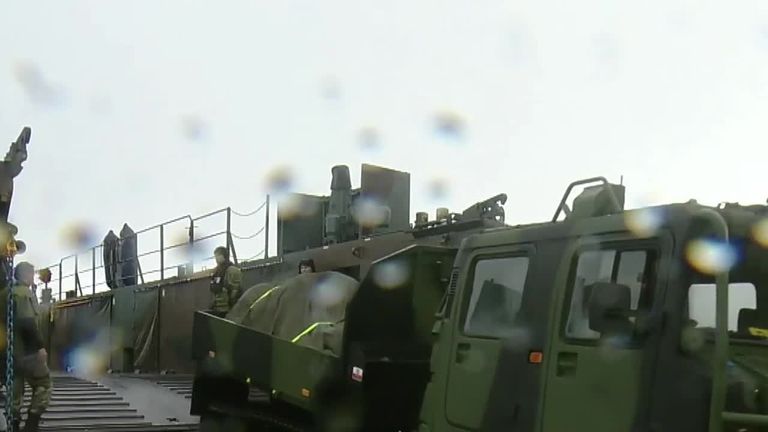Massive Trident Juncture NATO exercise to deter Russian threat
NATO troops are in Norway amid growing concerns about Russian aggression, but Moscow says it could be forced to respond.
Thursday 25 October 2018 19:55, UK
Around 50,000 NATO troops have started the organisation's largest exercise in decades, despite anger across the border in Russia.
Personnel from the alliance's 29 countries, along with partners Finland and Sweden, will be joined by 65 vessels, 250 aircraft and around 10,000 tanks, trucks and other military vehicles.
Trident Juncture, which runs until 7 November, is based around restoring Norway's sovereignty after an attack by a "fictitious aggressor".
The main fear for countries in this part of the world is growing aggression from Russia, which has annexed Crimea and is accused of destabilising Ukraine.
US Admiral James Foggo said that NATO troops would be "demonstrating our capability to bring a large force to bear on a problem that is an Article 5 problem".
Article 5 is the NATO pact of mutual defence among member countries.
The exercise is the biggest seen in Norway since the 1980s and its size is seen as a sign that the alliance is increasingly concerned about Russia.
For its part, Russia criticised the exercise, despite having held a similar one only last month - Vostok 2018.
During Vostok, Russia President Vladimir Putin had said: "We do not want and cannot have any aggressive plans."
Critics said Vostok was for the benefit of Russian civilians and the West, a show put on despite a shrinking Russian defence budget.
Defence minister Sergei Shoigu said the NATO exercise would be "simulating offensive military action", adding: "NATO's military activities near our borders have reached the highest level since the Cold War times."
Russia has been briefed about the exercise and given the opportunity to monitor it but Mr Shoigu said his country could be forced to respond, according to reports.
In a newspaper article, Nordic defence and foreign ministers said they saw "no military threats against the Nordic countries today, but we live in an unpredictable and uncertain time".
"Russia has both shown the will and ability to use military force to achieve strategic goals," they said.
"Cyber attacks and disinformation are actively used to create divisions between people in Europe as well as in the United States, which in turn challenges democratic institutions and our ability to reach common conclusions."






